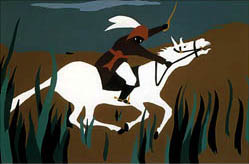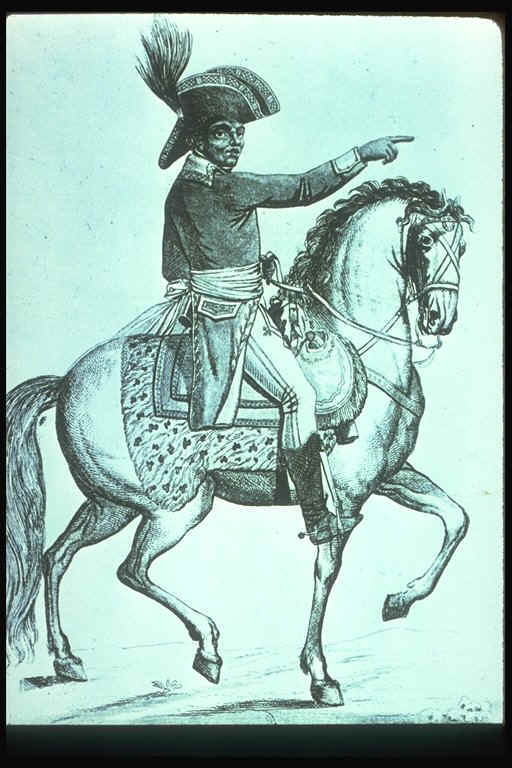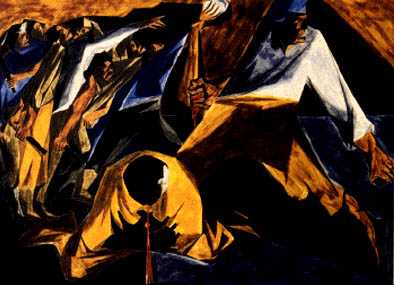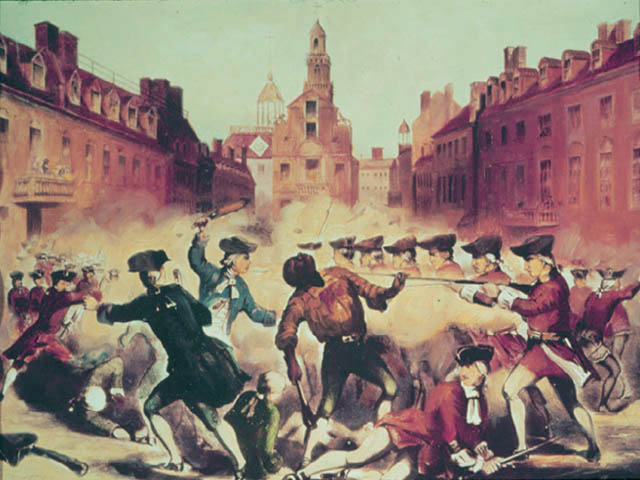Jacob Lawrence: Heroes

Toussaint L'Ouverture
Francois Dominique Toussaint was born a slave in Haiti.
He was a smart young man and his owner allowed him to get an education
so he could become a servant in his house. It was unusual for slaves
to be taught to read and write, but Toussaint read as many books as he could.
One of the people he read about was Julius Caesar who commanded
a large army and won many wars. When there was an uprising of slaves
against their owners, Toussaint helped the master who had been kind to him
to escape with his family. Then Toussaint led the other slaves in battles
against the French soldiers who were trying to rule Haiti and would not allow
an end to slavery. Toussaint was such a skillful general that he was
able to win many battles. For this he was called "L'Ouverture", which
meant, in French, that he could make an "opening" in the lines of the enemy
soldiers he was fighting. He was able to defeat them, even when they
had better weapons and more men than he did. Napoleon, who was the
emperor of France, said he would make peace with Toussaint. But he
lied and put Toussaint in a dungeon. Toussaint said when Napoleon captured
him, "In arresting me, you've only pulled down the trunk of the tree of freedom;
it will outgrow from its roots for they are deep and numerous". He
was right. Six months after Toussaint L'Ouverture died in a French
prison, Napoleon's soldiers gave up and left Haiti. It became
the first free black republic in the western hemisphere in 1804.

From Brooklyn College Portraits
Here is another picture of Toussaint L'Ouverture. It
is in a realistic style. Jacob Lawrence painted in a style called abstract.
Abstract art uses colors and shapes to show meanings and ideas about
the subject. Abstract artists aren't trying to make their subjects
look real. Instead, they want you to think about them yourself and
figure out what the pictures are about.
What do you think Jacob Lawrence wanted you to understand about Toussaint L'Ouverture when he painted him riding on his horse? What ideas and feelings do you get when you look at his picture?
Toussaint L'Ouverture was using figurative language when he said that Napoleon pulled down the trunk of the tree of freedom, but the roots would continue to grow. What do you think he meant by that? Who was the "trunk"? What were the "roots of freedom"?
Here are some more things you can read about Toussaint L'Ouverture.
What do you think Jacob Lawrence wanted you to understand about Toussaint L'Ouverture when he painted him riding on his horse? What ideas and feelings do you get when you look at his picture?
Toussaint L'Ouverture was using figurative language when he said that Napoleon pulled down the trunk of the tree of freedom, but the roots would continue to grow. What do you think he meant by that? Who was the "trunk"? What were the "roots of freedom"?
Here are some more things you can read about Toussaint L'Ouverture.
Books
Toussaint L'Ouverture: The Fight for Haiti's Freedom, by
Jacob Lawrence
Published: Simon and Schuster Children's, 1996
ISBN (Identification Number) 0689801262
Toussaint L'Ouverture, Lover of Liberty, by Laurence Santrey, Gershom Griffith
Published: Troll Books, 1994
ISBN (Identification Number) 0816728240
Published: Simon and Schuster Children's, 1996
ISBN (Identification Number) 0689801262
Toussaint L'Ouverture, Lover of Liberty, by Laurence Santrey, Gershom Griffith
Published: Troll Books, 1994
ISBN (Identification Number) 0816728240
Web Sites
This article has interesting details about Toussaint L'Ouverture's
life:
http://www.cobblestonepub.com/pages/ToussaintArticle.html
Here is a brief biography (scroll down the page to find his name) :
http://www.discoverhaiti.com/black_history_month.htm
Crispus Attucks
http://www.cobblestonepub.com/pages/ToussaintArticle.html
Here is a brief biography (scroll down the page to find his name) :
http://www.discoverhaiti.com/black_history_month.htm
 Painting by Jacob Lawrence, 1955
Painting by Jacob Lawrence, 1955 |
 Painting by Henry Pelham, 1770
Painting by Henry Pelham, 1770 |
Crispus Attucks
In 1770 British soldiers were sent by the King of England
to enforce the laws that the American colonists did not want to obey. The
colonists were especially angry about having to pay high taxes to England
and there was talk of going to war. There had been many complaints
about the soldiers rough treatment of the people of Boston and when it was
reported that a young boy had been beaten, a mob of angry men went out looking
for them. They waved sticks and threw snowballs at the British soldiers
and shouted insults at them.
Crispus Attacks was a slave who had run away from a farm in Massachusetts. He found work as a sailor on whaling ships and he was also a rope maker in Boston. Crispus Attacks was described as very big and strong man. A witness said that when the soldiers raised their rifles, Crispus Attucks "with one hand took hold of a bayonet, and with the other knocked the man down." The soldiers then opened fire, killing him and four other men.
It was called the Boston Massacre because none of the colonists had guns and it was said at the trial of the British soldiers that they had over reacted and should be found guilty of murdering the five men. The soldiers were not found guilty of murder and this caused more anger against the British.
Crispus Attucks was buried as a hero in the white people's cemetery and a monument was built to honor him as "the first to defy, the first to die" in the war for independence that America fought to become a free country.
These two very different looking pictures were both painted to illustrate this event in our country's history. Using his abstract style, Jacob Lawrence tries to get us to understand the subject. How do you think Crispus Attacks felt at that time? Henry Pelham painted the scene of the Boston Massacre realistically, as he saw it. He was there that day, and as a witness to the event, he is a primary source of information about what happened. Which details of his painting might have been used as evidence in the trial of the British soldiers?
You can read more about Crispus Attucks.
Crispus Attacks was a slave who had run away from a farm in Massachusetts. He found work as a sailor on whaling ships and he was also a rope maker in Boston. Crispus Attacks was described as very big and strong man. A witness said that when the soldiers raised their rifles, Crispus Attucks "with one hand took hold of a bayonet, and with the other knocked the man down." The soldiers then opened fire, killing him and four other men.
It was called the Boston Massacre because none of the colonists had guns and it was said at the trial of the British soldiers that they had over reacted and should be found guilty of murdering the five men. The soldiers were not found guilty of murder and this caused more anger against the British.
Crispus Attucks was buried as a hero in the white people's cemetery and a monument was built to honor him as "the first to defy, the first to die" in the war for independence that America fought to become a free country.
These two very different looking pictures were both painted to illustrate this event in our country's history. Using his abstract style, Jacob Lawrence tries to get us to understand the subject. How do you think Crispus Attacks felt at that time? Henry Pelham painted the scene of the Boston Massacre realistically, as he saw it. He was there that day, and as a witness to the event, he is a primary source of information about what happened. Which details of his painting might have been used as evidence in the trial of the British soldiers?
You can read more about Crispus Attucks.
Books
Crispus Attucks: Black Leader of Colonial Patriots, by
Dharathula H. Millender, Gray Morrow (Illustrator)
Published: Simon and Schuster Children's, 1982
ISBN (Identification Number) 0020418108
Cost of Freedom: Crispus Attucks and the Boston Massacre, by Joanne Mattern
Published: Rosen Publishing, 2004
ISBN (Identification Number): 0823943410
Published: Simon and Schuster Children's, 1982
ISBN (Identification Number) 0020418108
Cost of Freedom: Crispus Attucks and the Boston Massacre, by Joanne Mattern
Published: Rosen Publishing, 2004
ISBN (Identification Number): 0823943410
Web Sites
Here is an explanation of the Boston Massacre and Henry Pelham's picture
of it:You can see a portrait of Crispus Attacks and read more
about him:
http://www.africawithin.com/bios/crispus_attucks.htm
http://www.africawithin.com/bios/crispus_attucks.htm